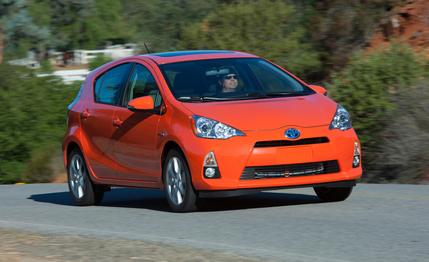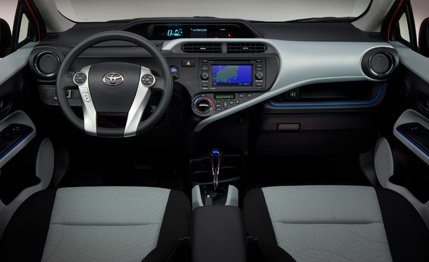 First Drive Review
First Drive Review
Americans aren’t fat because of high-fructose corn syrup, stress related to overly competitive work environments, or a sixth sense for locating the world’s finest couches; we posit that the extra pounds are sympathy weight. Our poor cars are so heavy, and we love them so much, that we go ahead and finish that 24-ounce porterhouse and, okay, it’s already an unhealthy meal, might as well have dessert, too.
On paper, the 2012 Prius C seems to have already pushed out a kid and enrolled in postpregnancy boot camp, as Toyota claims a curb weight of 2500 pounds (our estimate is closer to 2600, but you get the idea). That’s lighter than the Mazda Miata, the Mini Cooper hatchback, and most of the cars in our recent B-segment comparison test. It’s about 500 pounds lighter than a standard Prius, although under the skin, the C is more Yaris hybrid than downsized Prius.
Smaller, Shorter, Lighter, and Less…
At 67 pounds, the C’s battery pack is 24 lighter than the one in the Prius, and its 0.9-kilowatt-hour capacity is lower by about one-third. The smaller (19.1 inches shorter) car’s electric motor contributes 20 fewer horses than the standard Prius’s, and its gas engine—actually the same as powered the very first Prius—comparatively shrinks 0.3 liter and puts out 25 fewer horsepower. Its system total of 99 horses is 35 fewer than big brother’s. Although more compact, the C’s powertrain is constructed in the same way as the Prius’s, with an electric motor integrated into a CVT.

In many—most—hybrids, the goal is to make the hybrid functionality as transparent as possible. But not here. The C resists forward motion, second-guessing every throttle input. A little pressure on the accelerator nets higher engine rpm but no increase in velocity. The car seems merely to be preparing to accelerate. If the sound of hydrocarbons being produced at a greater rate doesn’t convince you that you don’t need to go faster and you push the pedal farther, the CVT reluctantly allows even more revs, and acceleration happens. It’s barely noticeable, but it happens. It might be lighter than a Prius, but the C’s power-to-weight ratio, at about 25 pounds per horsepower, is only slightly better than your author’s. With better gearing, he might be able to get to 60 mph in about the same 11 or so seconds, too. Driven like a normal car, the C is, quite frankly, frustrating.
So we also drove the C like a hypergreen Prius driver would, constantly pecking the EV button, accelerating so slowly we wanted to honk at ourselves, and approaching stops as if there were a three-inch nail sticking out of the brake pedal. Oddly, shifting the transmission into B, which slows the car more aggressively and feeds more energy to the batteries, turns off EV mode. Eco mode is also an option, but in it, the slipping-clutch feel of the CVT is augmented by a throttle so lazy you’ll think the throttle cable must be stretching, if only the car were so ancient as to have a throttle cable. Doing our eco best on a 15-mile loop, we managed an indicated 55 mpg. It could have been higher but for a moment’s indiscretion during which we accelerated to 70 under wide-open throttle. [Wince.] Going up a steep hill. (As the miles pass, fidelity only gets harder.) The good news is that the Prius C actually is capable of accelerating to 70 mph uphill. We weren’t sure it’d be able to. The bad news is that at no point during our 15-mile slug run did any other driver flash his lights, flick us off, or stick his head out the window and yell, “Get a move on, loser!” We’d feel better about America if someone had.